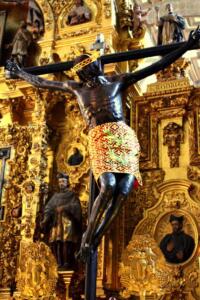About The Metropolitan Cathedral of the Assumption of the Most Blessed Virgin Mary into Heaven:
More commonly called The Metropolitan Cathedral, this is one of the most beautiful Cathedrals in the world. Inspired by the architecture of the Spanish city of Valladolid, it was built over the course of three centuries, from 1573 to 1813. As a result, like so many cathedrals built over a long period of time, it is a combination of baroque, neo-classical and neo-renaissance architeccture.
The bell towers house 25 bells, with the largest bell (Santa Maria de Guadalupe), weighing over 28,000 pounds). Some of the other bells have names as well, for example the one named Doña Maria. Gold coats almost every surface of the Cathedral.
In addition to the high altar, called “Altar de los Reyes” (“Altar of the Kings”), there are altars in each of the 16 side chapels.
The 16 side chapels in the Metropolitan Cathedral of Mexico City:
Chapel of Our Lady of the Agonies of Granada, Chapel of Saint Isidore, Chapel of the Immaculate Conception, Chapel of Our Lady of Guadalupe, Chapel of Our Lady of Antigua, Chapel of Saint Peter, Chapel of Christ and the Reliquaries, Chapel of the Holy Angels and Archangels, Chapel of Saints Cosme and Damian, Chapel of Saint Joseph, Chapel of Our Lady of Solitude, Chapel of Saint Eligius, Chapel of Our Lady of Sorrows, Chapel of the Lord of Good dispatch, the Chapel of Saint Philip of Jesus.
You can make an entire day’s pilgrimage just visiting each of these beautiful chapels.
The Miraculous Crucifix in the Cathedral in Mexico City:

One of the first things you will notice as you enter the Cathedral is the “Altar de Perdón” (“Altar of Pardon”) in the Chapel of Forgiveness (also called the Chapel of Our Poisoned Lord). Here you will see a crucifix called “El Seior del Veneno” (“The Poisoned Lord”). This crucifix was made by indigenous artisans in the 18th century. It is unusual for its deep black color. You will notice, that unlike most crucifixes, the legs of Jesus are twisted away from the viewer. There are several versions to the story as to why this is so….we present the one we have heard most often:
The story has it that a priest heard the confession of a man there who had stolen a treasure and in the process murdered someone. The priest said he could not give absolution unless the man returned the treasure and submitted to justice for the homicide. The man was repentant but not to the point of following the priest’s advice. Even though a priest would never reveal the secrets heard in confession, the man felt that he had better play it safe by killing his confessor.
The priest had the pious custom of praying before and then kissing the crucifix before retiring each night from the chapel. The murderer knew of the practice and so smeared the feet of the corpus of Jesus on the cross with poison. Supposedly, the criminal hid in the shadows of the darkened church in order to watch the deadly kiss. As the priest leaned down to kiss the image, the murderer was shocked to see the body of the Christ shift on the cross and swing his feet away from the priest’s face. The legs supposedly then remained in that position, saving the priest. Some say the murderer repented and others that he ran away frightened.
The crucifix was originally in the Dominican Church but was moved here to the Cathedral.
Finding the Metropolitan Cathedral in Mexico City:
Address: P.za de la Constitución S/N, Centro Histórico de la Cdad. de México, Centro, Cuauhtémoc, 06000 Ciudad de México, CDMX, Mexico
email: info@catedralmetropolitana.mx
Click here for the official website of the Metropolitan Cathedral in Mexico City.

